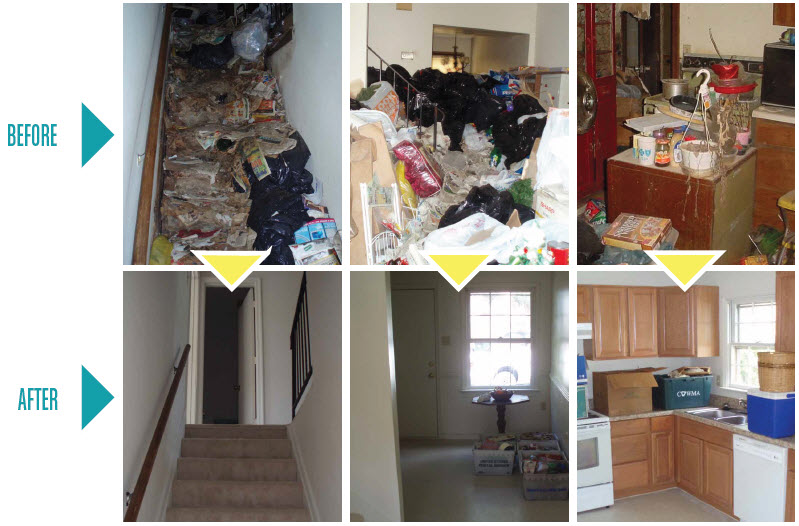A lot of people can have a tough time understanding hoarding and how hoarders can let themselves accumulate an excessive amount of stuff in their living spaces. What many people do not realize about hoarding is that it is not a choice, but a mental disorder that manifests as the symptoms that we commonly associate with hoarding.
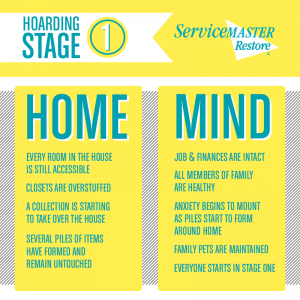
Hoarding in general is defined as an inability or difficulty in ridding of belongings from the home, no matter their value. It is a behavior that can manifest as a symptom of several different mental disorders or other underlying issues such as anxiety or depression. Among the disorders hoarding is commonly associated with are attention deficit hyperactivity disorder (ADHD), depression, obsessive compulsive disorder (OCD), and obsessive compulsive personality disorder. Hoarding can also be associated with eating disorders, dementia, and psychosis, but this isn’t as common. Furthermore, many hoarding cases are triggered by an emotional event, particularly one that results in grief.
In the United States, 10-15 million people struggle with hoarding, which only becomes more severe as the disorder develops. Excessive hoarding creates very dangerous living conditions in the home as the clutter increases the risk of fires and injuries, blocks pathways and exits, and harbors mold, bacteria, and pests. This not only threatens the health and well-being of the individual affected, but also that of their family members living in the home.
If you can spot hoarding symptoms before the clutter buildup gets out of control, then you can help the individual and get professional assistance to clean and restore the home. The following are common warning signs of a hoarder that you should look for if you suspect that a friend or family member may be hoarding.
Hoarding – Warning Signs
Excessive Clutter
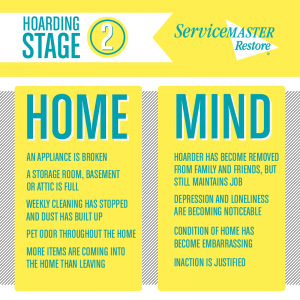
Messes and some clutter buildup in the home are natural, but the excessive buildup and disregard for discarding clutter isn’t. Excessive clutter is a key sign of hoarding. When there’s so much stuff taking up space in a room, it cannot be used for its intended purpose.
If you suspect someone you know is a hoarder, pay attention to the items they are keeping in their home. It’s one thing to be a collector who gathers specific items and other things of value, but it’s another thing to accumulate items that are invaluable and useless to keep. There is typically no rhyme or reason to the objects collected by a hoarder. Any object that ends up in the home will remain and become part of the clutter.
The materials being hoarded can include bags, boxes, clothing, food, newspapers, appliances, photographs, and even animals among others.
Hazards
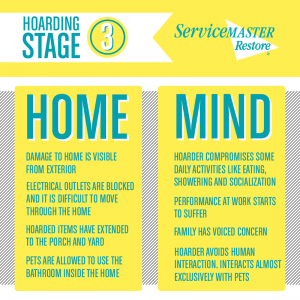
When so much stuff accumulates in an area, the stacks and piles of items block access to the space and make it unsafe. If someone tries to make their way through the area, it would be easy to suffer an accident because of the lack of space to move around safely. There is a high risk of tripping over the objects throughout the home and large stacks can even fall over on people and cause injuries. The clutter also makes it much more difficult to evacuate the home in case of an emergency like a fire.
Furthermore, the accumulation of objects can attract bacteria and mold growth, especially if food and other organic items are kept around. The presence of bacteria and mold increase the risk of negative health effects and these organic materials can also attract pests such as rodents and insects.
Avoidance
If someone who you suspect of hoarding is selective with whom they let in their homes — if they let anyone in at all — this may be a sign that they’re hoarding. Those who struggle with hoarding are often embarrassed by the condition of their homes and usually will not let anyone inside to see its condition.
By preventing people from coming into their residence, they are also avoiding their hoarding problems instead of confronting them.
Physical Replacement
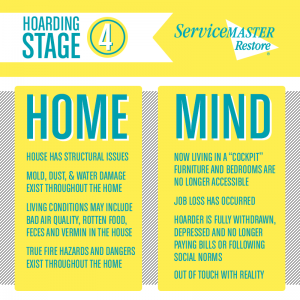 Hoarders whose disorder has intensified may begin placing self-worth in physical items. They will purchase and accumulate things in bulk to have more belongings with them.
Hoarders whose disorder has intensified may begin placing self-worth in physical items. They will purchase and accumulate things in bulk to have more belongings with them.
This physical replacement can be a problem when a case of hoarding has become extreme. In this case, the person will replace their family and friends with objects. This is especially likely if the person has lost a loved one. In response to the loss, the person will deal with it by filling that void with items.
Get Help for Hoarding
While the aforementioned are the most common signs of a hoarder, hoarding is not the same for every person affected by the disorder. Hoarding can manifest itself in various ways depending on the individual, but some combination of the warning signs discussed above are usually present.
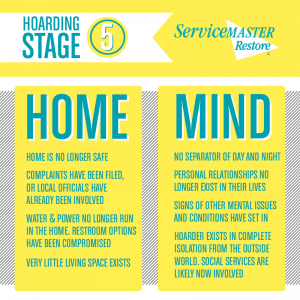 If you find that someone you know is exhibiting such signs of hoarding, reach out to them and discuss it with them before their hoarding becomes more severe. Help them understand that their behaviors are putting themselves and their family in danger. Only when the affected individual decides to proceed with the clean up of their home should you involve a professional to help.
If you find that someone you know is exhibiting such signs of hoarding, reach out to them and discuss it with them before their hoarding becomes more severe. Help them understand that their behaviors are putting themselves and their family in danger. Only when the affected individual decides to proceed with the clean up of their home should you involve a professional to help.
Our professionals at ServiceMaster Disaster Restoration and Recovery can assist with hoarding clean-up through our hoarding and estate cleaning services. We understand the sensitive nature of the situation and we take a compassionate approach in conducting our services. We work with the individual and their loved ones to help cut down on clutter and return their homes to safe living conditions. We can even refer clients to a local therapist or social services so they can get treatment for their underlying disorders.

Steve VanDenBerg is the owner of ServiceMaster Disaster Restoration and Recovery. He has over 30 years of experience working within the restoration industry and successfully leading start-ups, turnarounds, acquisitions and mergers, and rapidly growing companies.
Steve earned his BS in Business & Accounting from Calvin University in Grand Rapids, MI and began working for DSI Holdings as their Chief Financial Officer. When Steve began with DSI Holdings, they were running an underperforming ServiceMaster Restore franchise with one location. Steve implemented new policies and procedures for accounting and finance as well as a professional sales plan that increased profits eightfold over his time as the CFO. He was then promoted to President and CEO and in this time, he expanded the company from two locations with $4M in sales to 12 locations and $45M in sales. DSI Holdings became one of the largest disaster restoration companies in the U.S. and helped with major restoration projects throughout the U.S. and around the world.
Steve purchased ServiceMaster DRR in 2015 when the business was in decline. Drawing on his years of experience in turning around struggling ServiceMaster franchises, Steve overhauled our operations, including finance, sales, and marketing, which led to a quick turnaround. Within Steve’s first 24 months, sales increased by 60 percent. Steve also helped greatly improve our operating margins and established a relationship with California’s largest residential insurance company. Under Steve’s leadership, we have become one of the largest disaster restoration providers in California.
Steve has found great success in turning around struggling and stagnant restoration franchises by changing the business model and strategy, greatly increasing sales and profits. Many of the changes he has implemented have even been adopted by the franchisor into their operating model.



